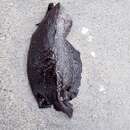en
names in breadcrumbs


Opisthobranch molluscs are mainly marine and can be found in shore waters. One of their principal
features is the lost of the calcarean shell, which in some groups of opisthobranchs is substituted by ceratas. For the Venezuelan coast has been reported seven species of the Aplysiomorpha, commonly known as as sea slugs or sea hares: Aplysia juliana, A. dactylomela, A. cervina, A. parvula, A. brasiliana, Bursatella leachii and Dolabrifera dolabrifera. In this study is reported for the first time Aplysia morio in Venezuela, found specifically at two locations of the Nueva Esparta State, playa Valdés (Margarita Island) and bahia de Charagato (Cubagua Island). The current distribution of A. morio is from Rhode Island to Texas (USA) continuing to México, Bahamas, Trinidad and Venezuela.
Aplysia morio, the Atlantic black sea hare or sooty sea hare, is a species of sea slug, a marine gastropod mollusk in the family Aplysiidae, the sea hares. It lives in warm waters in the Caribbean Sea and off the south and southeastern coast of the United States, where it feeds on seaweed.
Aplysia morio is a bulky sea slug that can grow to a length of 30 cm (12 in) or more. It is usually dark chocolate brown to blackish in colour, and sometimes dark lines are visible on the head and flanks. The tentacles are curled and shaped rather like rabbit's ears. They are rich in nerve cells and are equipped with receptor organs. The shell is a fragile disc, hidden within the mantle, and the foot has large flaps at the side called parapodia which are used for swimming.[2][3]
This species is found in the semi-tropical western Atlantic Ocean. Its range includes the eastern coast of the United States, Bermuda, the West Indies, Florida, the Caribbean Sea, the Gulf of Mexico and Venezuela. It typically lives in shallow water, down to depths of about 40 m (130 ft) in areas where there is little wave action. It is usually found on rocky surfaces among the algae that it feeds on, but is also found on sandy seabeds.[2]
Aplysia morio feeds on algae. In Bermuda juveniles seem to feed almost exclusively on species of the red alga Laurencia, even though there is a wide range of algae to choose from. Adults widen their diet slightly to include Palmaria palmata. The animal either crawls over the seaweed or rears up to grasp the fronds with its radula and the odontophore (cartilage) that supports it. It may also swim, in a manner reminiscent of a manta ray, when looking for food.[2]
An adult is a hermaphrodite that can act as a male and a female at the same time. As the penis of one individual is inserted into the genital opening of another, chains or clusters of mating sea hares can form. The initially spawning individual releases chemical signals that can trigger spawning in others, which may culminate in a mass spawning event. Fertilized eggs hatch and develop into veliger larvae, which drift with the plankton for at least a month and settle onto Laurencia seaweed.[2]
Aplysia morio, the Atlantic black sea hare or sooty sea hare, is a species of sea slug, a marine gastropod mollusk in the family Aplysiidae, the sea hares. It lives in warm waters in the Caribbean Sea and off the south and southeastern coast of the United States, where it feeds on seaweed.
Aplysia morio es una especie de molusco de la familia Aplysiidae.[1] Fue descrita originariamente en el género Thethys, con base en material encontrado en Bermuda.[2] Como otras especies del género Aplysia, esta especie es herbívora y de hábitos bentónicos.[3]
El cuerpo es de color marrón obscuro a negro sin ningún tipo de puntos pero algunas veces se observan líneas en la cabeza. Los rinóforos y las branquias son del mismo color que el cuerpo. La cabeza y el cuello son más estrechos respecto al resto del cuerpo. Los parapodios son muy grandes y les sirven para nadar. Tiene una concha delgada y transparente situada en la parte interior de los parapodios, junto a las branquias. Alcanza hasta los 400 mm de longitud.[2][4]
Esta especie fue descrita por primera vez en Bermudas. Se distribuye en la costa oeste del Océano Atlántico en Estados Unidos (Rhode Island, Georgia, Florida y Texas), en México, Bermuda y Bahamas.[2][3][4][5]
Habita en arrecifes de coral.
No se encuentra bajo ninguna categoría de riesgo.
Aplysia morio es una especie de molusco de la familia Aplysiidae. Fue descrita originariamente en el género Thethys, con base en material encontrado en Bermuda. Como otras especies del género Aplysia, esta especie es herbívora y de hábitos bentónicos.
Aplysia morio is een slakkensoort uit de familie van de Aplysiidae.[1] De wetenschappelijke naam van de soort is voor het eerst geldig gepubliceerd in 1901 door A. E. Verrill.
Bronnen, noten en/of referenties